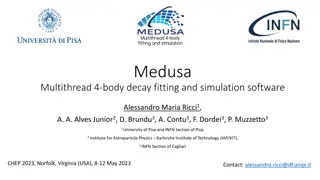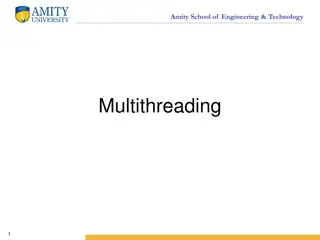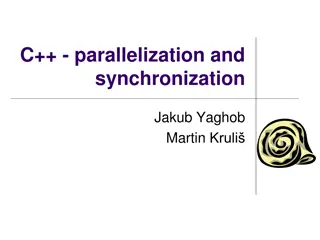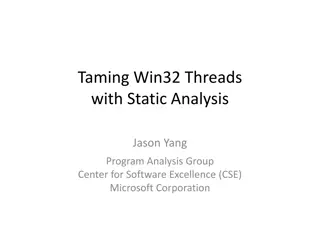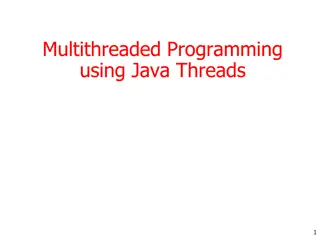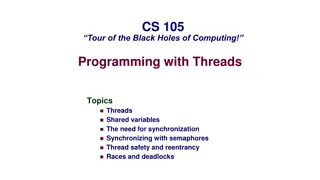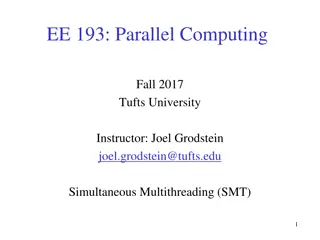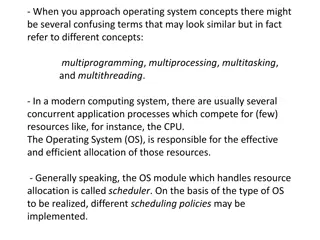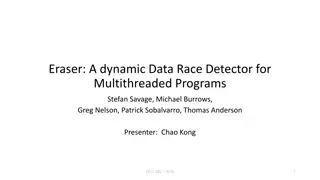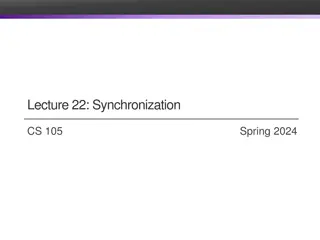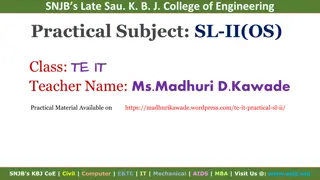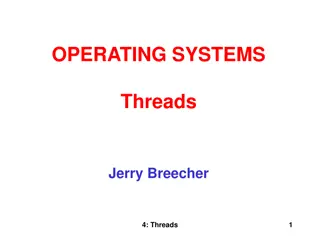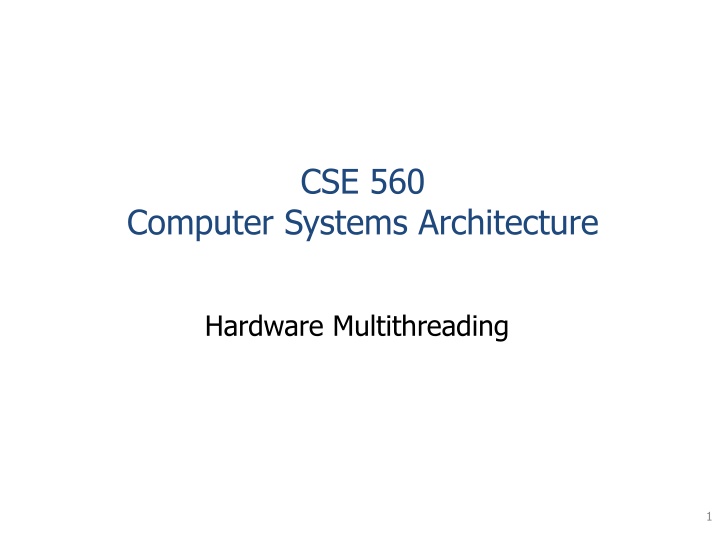
Computer Systems Architecture: Multithreading for Performance Optimization
Explore the significance of multithreading in computer systems architecture, its impact on performance, and the different implementations like coarse-grained, fine-grained, and simultaneous multithreading. Learn how multithreading enhances CPU utilization and the importance of balancing performance and utilization for efficient system operation.
Uploaded on | 0 Views
Download Presentation

Please find below an Image/Link to download the presentation.
The content on the website is provided AS IS for your information and personal use only. It may not be sold, licensed, or shared on other websites without obtaining consent from the author. If you encounter any issues during the download, it is possible that the publisher has removed the file from their server.
You are allowed to download the files provided on this website for personal or commercial use, subject to the condition that they are used lawfully. All files are the property of their respective owners.
The content on the website is provided AS IS for your information and personal use only. It may not be sold, licensed, or shared on other websites without obtaining consent from the author.
E N D
Presentation Transcript
CSE 560 Computer Systems Architecture Hardware Multithreading 1
This Unit: Multithreading (MT) Application Why multithreading (MT)? Utilization vs. performance Three implementations Coarse-grained MT Fine-grained MT Simultaneous MT (SMT) OS Compiler Firmware CPU I/O Memory Digital Circuits Gates & Transistors 2
Performance And Utilization Performance (IPC) important Utilization (actual IPC / peak IPC) important too Even moderate superscalars (e.g., 4-way) not fully utilized Average sustained IPC: 1.5 2 < 50% utilization Mis-predicted branches Cache misses, especially L2 Data dependences Multi-threading (MT) Improve utilization by multi-plexing multiple threads on single CPU One thread cannot fully utilize CPU? Maybe 2, 4 (or 100) can 3
Simple Multithreading Time evolution of issue slot 4-issue processor time cache miss Superscalar 4
Simple Multithreading Time evolution of issue slot 4-issue processor time cache miss Fill in with instructions from another thread Multithreading Superscalar Where does it find a thread? Same problem as multi-core Same shared-memory abstraction 5
Latency vs Throughput MT trades (single-thread) latency for throughput Sharing processor degrades latency of individual threads + But improves aggregate latency of both threads + Improves utilization Example Thread A: individual latency=10s, latency with thread B=15s Thread B: individual latency=20s, latency with thread A=25s Sequential latency (first A then B or vice versa): 30s Parallel latency (A and B simultaneously): 25s MT slows each thread by 5s + But improves total latency by 5s Different workloads have different parallelism SpecFP has lots of ILP (can use an 8-wide machine) Server workloads have TLP (can use multiple threads) 6
MT Implementations: Similarities How do multiple threads share a single processor? Different sharing mechanisms for different kinds of structures Depend on what kind of state structure stores No state: ALUs Dynamically shared Persistent hard state (aka context ): PC, registers Replicated Persistent soft state: caches, bpred Dynamically partitioned (like multi-program uni-processor) TLBs need thread ids, caches/bpred tables don t Exception: ordered soft state (BHR, RAS) is replicated Transient state: pipeline latches, ROB, RS Partitioned somehow 7
MT Implementations: Differences Main question: thread scheduling policy When to switch from one thread to another? Related question: pipeline partitioning How exactly do threads share the pipeline itself? Depends on What kind of latencies (specifically, length) you want to tolerate How much single thread performance you are willing to sacrifice Three designs 1. Coarse-grain multithreading (CGMT) 2. Fine-grain multithreading (FGMT) 3. Simultaneous multithreading (SMT) 8
The Standard Multithreading Picture Time evolution of issue slots Color = thread time CGMT FGMT SMT Superscalar 9
Coarse-Grain Multithreading (CGMT) + Sacrifices little single thread performance (of 1 thread) Tolerates only long latencies (e.g., L2 misses) Thread scheduling policy Designate a preferred thread (e.g., thread A) Switch to thread B on thread A L2 miss Switch back to A when A L2 miss returns Pipeline partitioning None, flush on switch Can t tolerate latencies shorter than 2x pipeline depth Need short in-order pipeline for good performance Example: IBM Northstar/Pulsar 10
CGMT Original: regfile I$ B P D$ CGMT: thread scheduler regfile regfile I$ B P D$ L2 miss? 11
Fine-Grain Multithreading (FGMT) Sacrifices significant single thread performance + Tolerates latencies (e.g., L2 misses, mispredicted branches, etc.) Thread scheduling policy Switch threads every cycle (round-robin), L2 miss or no Pipeline partitioning Dynamic, no flushing Length of pipeline doesn t matter so much Need a lot of threads 12
Fine-Grain Multithreading (FGMT) Extreme example: Denelcor HEP So many threads (100+), it didn t even need caches Failed commercially (or so we thought!) Not popular today (in traditional processors) Many threads many register files One commercial example is Cray Urika (with historical ties to Denelcor HEP, Burton Smith architected both) Is popular today (in GPUs) SIMT (single instruction, multiple threads) Data parallel, in-order execution Pipeline isn t the same as what we ve been studying, but it does use FGMT 13
Fine-Grain Multithreading FGMT: Multiple threads in pipeline at once (Many) more threads regfile thread scheduler regfile regfile regfile I$ B P D$ 14
Vertical and Horizontal Under-Utilization FGMT and CGMT reduce vertical under-utilization Nothing issues in a given cycle Do not help with horizontal under-utilization Not all issue slots issue in a given cycle (for superscalar) time CGMT FGMT SMT 15
Simultaneous Multithreading (SMT) What can issue insns from multiple threads in one cycle? Same thing that issues insns from multiple parts of same program out-of-order execution Simultaneous multithreading (SMT): OOO + FGMT Aka hyper-threading Observation: once insns are renamed, scheduler doesn t care which thread they come from (well, for non-loads at least) Some examples IBM Power5: 4-way issue, 2 threads Intel Pentium4: 3-way issue, 2 threads Intel Core i7: 4-way issue, 2 threads Alpha 21464: 8-way issue, 4 threads (canceled) Notice a pattern? #threads (T) x 2 = # issue width (N) 16
Simultaneous Multithreading (SMT) Original: map table regfile I$ B P D$ SMT: Replicate map table, share (larger) physical register file map tables thread scheduler regfile I$ B P D$ 17
SMT Resource Partitioning Physical regfile and insn buffer entries shared at fine-grain Physically unordered and so fine-grain sharing is possible How are physically ordered structures (ROB/LSQ) shared? Fine-grain sharing (below) entangles commit (and squash) Allowing threads to commit independently is important thread scheduler map tables regfile I$ B P D$ 18
Static & Dynamic Resource Partitioning Static partitioning (below) T equal-sized contiguous partitions No starvation, sub-optimal utilization (fragmentation) Dynamic partitioning P > T partitions, available partitions assigned on need basis Better utilization, possible starvation ICOUNT: fetch policy prefers thread with fewest in-flight insns Couple both with larger ROBs/LSQs regfile I$ B P D$ 19
Multithreading Issues Shared soft state (caches, branch predictors, TLBs, etc.) Key example: cache interference General concern for all MT variants Can the working sets of multiple threads fit in the caches? Shared memory threads help: Single Program Multiple Data (SPMD) + Same insns share I$ + Shared data less D$ contention MT is good for workloads with shared insn/data To keep miss rates low, SMT might need a larger L2 (which is OK) Out-of-order tolerates L1 misses Large physical register file (and map table) physical registers = (#threads x #arch-regs) + #in-flight insns map table entries = (#threads x #arch-regs) 20
Subtleties Of Sharing Soft State What needs a thread ID? Caches TLBs BTB (branch target buffer) BHT (branch history table) 21
Necessity Of Sharing Soft State Caches are shared naturally Physically-tagged: address translation distinguishes different threads TLBs need explicit thread IDs to be shared Virtually-tagged: entries of different threads indistinguishable Thread IDs are only a few bits: enough to identify on-chip contexts 22
Costs Of Sharing Soft State BTB: Thread IDs make sense entries are already large, a few extra bits / entry won t matter Different thread s target prediction definite mis-prediction BHT: make less sense entries are small, a few extra bits / entry is huge overhead Different thread s direction prediction possible mis-prediction Ordered soft-state should be replicated Examples: Branch History Register (BHR*), Return Address Stack (RAS) Otherwise they become meaningless Fortunately, it is typically small 23
Multithreading vs. Multicore If you wanted to run multiple threads would you build a A multicore: multiple separate pipelines? A multithreaded processor: a single larger pipeline? Both will get you throughput on multiple threads Multicore core will be simpler, possibly faster clock SMT will get you better performance (IPC) on a single thread SMT is basically an ILP engine that converts TLP to ILP Multicore is mainly a TLP (thread-level parallelism) engine Do both Sun s Niagara (UltraSPARC T1) 8 processors, each with 4-threads (non-SMT threading) 1GHz clock, in-order, short pipeline (6 stages or so) Designed for power-efficient throughput computing 24
Multithreading Summary Latency vs. throughput Partitioning different processor resources Three multithreading variants Coarse-grain: no single-thread degradation, but long latencies only Fine-grain: other end of the trade-off Simultaneous: fine-grain with out-of-order Multithreading vs. chip multiprocessing 28

